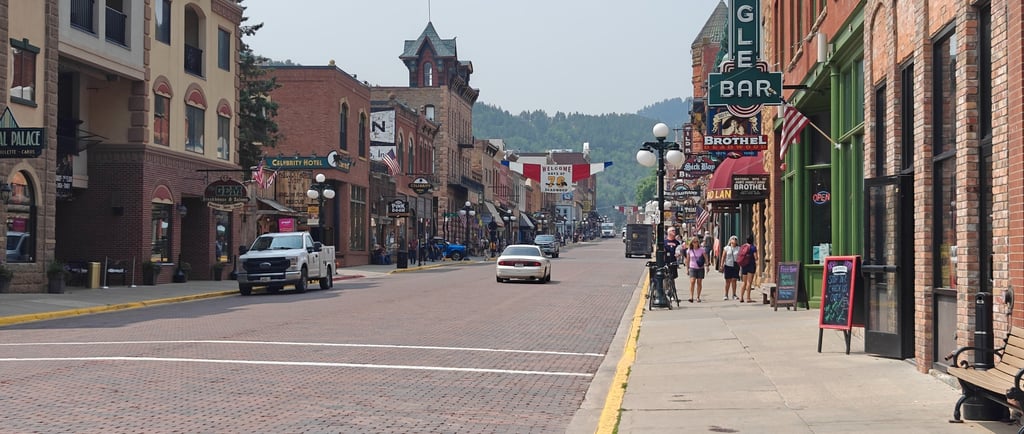July 23rd – Adventure Day 49: Exploring the Black Hills and Badlands


Discovering Deadwood, SD
July 23rd marked the beginning of an exciting 2-day adventure through the Black Hills and Badlands area. Leaving the cozy confines of my cabin, I rode my motorcycle to the historic town of Deadwood, SD. Nestled in the northern Black Hills, Deadwood is a town rich in history, famous for its Wild West past. The town is a living museum with restored buildings and streets that echo tales of legendary figures like Wild Bill Hickok and Calamity Jane.
My journey began with a leisurely stroll down Main Street, where the historic architecture instantly transported me back to the late 19th century. The wooden facades and old-style storefronts speak volumes about the town's storied past. Each corner of Deadwood seemed to whisper secrets of gunfights, gold rushes, and legendary poker games.
A visit to the Adams Museum was next on my itinerary. This museum offers a comprehensive look into the history of Deadwood and the surrounding Black Hills. Exhibits range from Native American artifacts to memorabilia from the gold rush era, providing a rich narrative of the area's evolution. One of the most intriguing displays was the personal belongings of Wild Bill Hickok, which added a tangible connection to the stories I had read about.
The ambiance of Deadwood is a blend of historical reverence and modern-day charm, offering a unique glimpse into America's frontier era. Whether exploring the meticulously preserved buildings or learning about the town's colorful past, Deadwood provides an immersive experience that honors its wild and storied heritage.
Experiencing the Sturgis Motorcycle Rally Location
After departing Deadwood, my next destination was Sturgis, SD, a town globally renowned for its annual motorcycle gathering, the Sturgis Motorcycle Rally. Each year, this event draws hundreds of thousands of bikers from all corners of the world, creating a grand celebration of motorcycle culture. Although the official rally dates were still a few weeks away, the town was already abuzz with preparations, making it evident how significant this event is to Sturgis.
My first stop in Sturgis was the Sturgis Motorcycle Museum & Hall of Fame. This institution offers a comprehensive look into the history of the rally and its profound impact on the local community. The museum houses an impressive collection of vintage motorcycles and memorabilia, chronicling the evolution of this iconic event. Through various exhibits, I gained insight into the rally's origins, its growth over the decades, and the stories of the individuals who have shaped its legacy.
Strolling through the streets of Sturgis, I noticed they were lined with biker-themed shops, bars, and eateries, each contributing to the town's unique atmosphere. The camaraderie among the early-arriving bikers was palpable, as they shared stories and prepared for the upcoming festivities. This vibrant environment provides a glimpse into the rich traditions and cultural significance of the Sturgis Motorcycle Rally. The sense of excitement and anticipation in the air was infectious, offering a preview of the larger-than-life experience that awaited during the official rally dates.
Visiting Sturgis ahead of the rally allowed me to appreciate the meticulous planning and community involvement that goes into hosting such a monumental event. It also highlighted the rally's role in fostering a sense of unity and pride among motorcycle enthusiasts. From the museum's historical narratives to the lively streets, my time in Sturgis provided a deep appreciation for the rally's enduring legacy and the vibrant culture that defines this remarkable celebration.
Visiting the Geographical Center of the United States
I had the opportunity to explore a unique landmark: the geographical center of the contiguous United States. This significant site is located near Belle Fourche, South Dakota, and is marked by a monument that underscores its importance. While it may seem like just a point on a map, the geographical center is a potent symbol of the vast and diverse landscape that constitutes the United States.
Upon arriving, I was immediately struck by the serene atmosphere surrounding the monument. The geographical center is not only a key landmark but also a scenic spot that offers panoramic views of the surrounding countryside. The rolling hills and expansive fields provide a picturesque backdrop, enhancing the sense of awe that accompanies standing at the heart of the nation.
As I stood before the monument, I took a moment to reflect on the incredible journey that had brought me to this point. The miles I had traveled were a testament to the sheer scale and beauty of the country. Each step of my adventure had been filled with diverse landscapes and unique experiences, all leading up to this significant location.
The monument itself is a simple yet profound marker, signifying the central point of the contiguous United States. It serves as a reminder of the unity and diversity that define the nation. The geographical center is a place where one can appreciate the country's vastness, from the bustling cities to the quiet, open spaces that lie between them.
Visiting this landmark was a memorable highlight of my Black Hills and Badlands adventure. It provided a unique perspective on the journey and a deeper appreciation for the country's geographical and cultural richness. The geographical center of the United States is more than just a point on a map; it is a testament to the expansive and varied tapestry that makes up this incredible nation.
